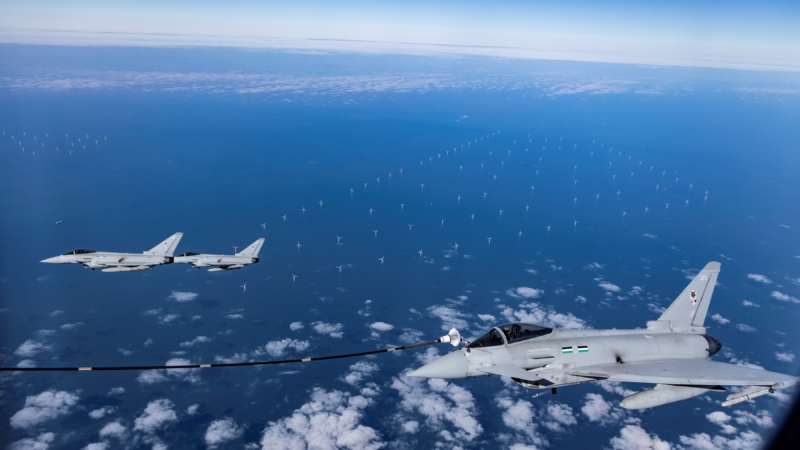Sustainable Skies
12 May 2023We recently attended the Sustainable Skies World Summit in Farnborough with representatives from across the aviation industry as Sustainable Aviation (SA) announced its updated roadmap to Net Zero.
The Summit unites industry leaders from across the world to discuss the opportunities and challenges that lie ahead on the path to Net Zero. With panel speakers including Willie Walsh, Director General of IATA, and Sir Stephen Hillier, Chair of CAA, the conference has doubled in size since its inaugural event last year and hosted organisations such as Rolls-Royce, British Airways, Reaction Engines and GKN Aerospace.
There is a clear ongoing commitment to achieving Net Zero aviation emissions by 2050, and the technology and innovation required to get us there is travelling at a rate of knots – but there are complex challenges that need to be overcome.
The Summit got off to a flying start when delegates witnessed a flypast of an RAF Voyager, powered by a 43% blend of sustainable aviation fuel (SAF). The A330 aircraft also successfully completed an air-to-air refuelling mission over the North Sea, where Typhoons received the SAF blend refuel – the first time SAF has been used in air-to-air refuelling. I was fortunate to be onboard and it is certainly a flight I will never forget. I am excited to see the continued progress of SAF becoming mainstream in aviation.
The conference kicked off with SA announcing its updated roadmap to Net Zero with a continued commitment to the reduction of aviation produced greenhouse gases. Core to the roadmap are: speeding up the design, manufacture, and rollout of zero emission aircraft and upgrade vital infrastructure at UK airports and in the skies; and accelerating the production of SAF through investment in new SAF plants, supporting scientific research on a larger scale and helping drive down production costs.
In another important announcement, the Jet Zero Council, a partnership between industry and Government, announced its objective of delivering 10% SAF in UK aviation fuel by 2030 and zero emission transatlantic flight within a generation.
SAF dominated the conversation, and we heard about the work already underway to create the infrastructure required to meet future demand. In the UK, there is Government backing for five SAF plants to be under construction by 2025, although this won’t be enough to achieve the desired 10% SAF target by 2030. Luis Gallego, CEO of IAG Group said that no fewer than 14 plants are needed in the UK to reach this goal.
The Secretary of State for Transport, the Rt Hon Mark Harper MP, was there for Jet Zero and mentioned that NATS’ role in airspace modernisation is “essential to making our invisible highways as efficient as possible” in his ministerial address. He also pointed out that industry collaboration and cooperation will be the key to success as technologies continue to evolve. Another nod to the crucial role airspace modernisation plays came from ACOG’s Mark Swan, citing NATS’ West airspace deployment and its contribution to saving 12,000 tonnes of carbon emissions annually. SA’s roadmap anticipates that within UK airspace, overall emissions savings will equate to around 1Mt CO2 by 2030.

Rt Hon Mark Harper MP addresses the room
One of the loudest messages to come from the conference was from industry to Government, highlighting the need for a clear policy framework for SAF. We can’t continue to shy away from mandates and the policy supportive measures required to help the market develop.
The scale of change across industry is going to be immense and will rely on collaboration and contribution from outside of aerospace. Backing and innovation from the financial industry is needed, but with a lack of certainty around ROI for investors, this is a barrier that needs urgent attention from policymakers.
The journey to Net Zero was described as “the greatest strategic challenge for aerospace” by Sir Stephen Hillier, Chair of CAA. As you would expect, the regulator’s primary focus is safety and Sir Stephen acknowledged the role they have to play in creating the right conditions for the aviation sector to take action to reduce its environmental impact. We look forward to their continued support and collaboration as our endeavours in airspace modernisation and network upgrades progress.
While SA’s roadmap deals with CO2 and doesn’t include the non-CO2 effects of aviation such as contrails, it’s important to note that combating non-CO2 emissions is required to pave the way to ‘True Zero’ aviation emissions. NATS’ ongoing research with Airbus in the SESAR3 CICONIA project continues to improve our understanding of non-CO2 outputs. Our work with industry partners enables us to acknowledge the true climate impact of non-CO2, and how we can enable our operations to mitigate contrails.
Within the exhibition, there was plenty of cross-industry representation including drone manufacturers and operators, airlines and airports, aerospace prime, tier one and OEM organisations. Rolls-Royce showcased an engine for hydrogen propulsion, and American company WheelTug had its in-wheel electric aircraft taxiing system on display.
We also saw physical manifestations of the innovation and technology that will propel a sustainable future for aviation, and in some examples, innovations that are already in circulation. The VELIS Electro, manufactured by Pipistrel, is the UK’s first certified fully electric aircraft that is currently in operation with NEBO Air, whose mission is to promote and grow sustainable aviation in the UK. The same aircraft is currently in service with Californian not-for-profit organisation ‘New Vision Aviation’, a charity that provides young people from disadvantaged backgrounds with the opportunity to experience flying and training for careers in aviation. New Vision claims the electric aircraft could reduce the costs of training for a pilot’s licence by two thirds. This is something I look forward to discussing with Brian Wheeler as he starts his secondment to Aerobility, the British charity that we support.

VELIS Electro
Comments
Please respect our commenting policy and guidelines when posting on this website.
